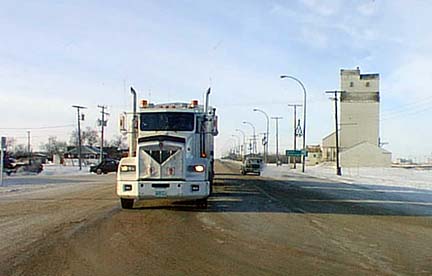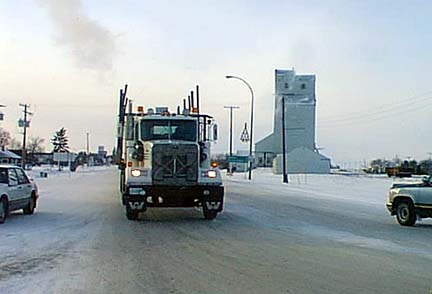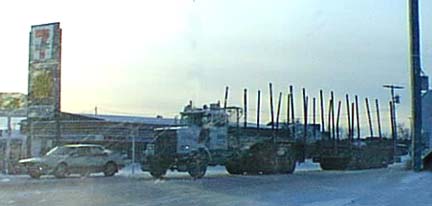 |
| FTLComm - Tisdale - January 15, 1999 |
Every time you drive through the junction of highways 35 and 3 you are passing through
one of Saskatchewan's busiest intersections and it seemed to me that every time I
come to a stop I am seeing a semi of one kind or another about to cross. So, for
the past few days I have whipped out my camera and snapped a picture of these monsters
as they make their way to and from their destinations pausing at this four way stop
sign.
From these pictures you can see this random sample demonstrates the wide variety
of goods being hauled. Above is a general freight unit used to haul dry products
and on the right is a grain truck. |
 |
| With the grain terminals that are located around Tisdale it seems appropriate that
many of the trucks one sees at this stop sign are grain hauler Many of course are
"B" trains with two trailers behind the tractor. It is interesting to note
that the "B" train almost catches our attention on the highway, this sample
does not include one as the major of trucks on the road are not of this type. |
 |
| Many companies depend on their own fleet of trucks to supply their retail outlets
while other merchants depend on a wide variety of independent and large company hauling
companies. There is a growing trend for truckers to be independent operators pulling
a load for a company or depot. These independent driver owners have a difficult time
of it as competition is extreme and they have to keep their costs to a minimum to
stay in business. This often means that they are only making enough to cover costs
and profits are few and far between. |
 |
| Units like this one are vital to the grocery business. As you can see this is a environmentally
controlled truck which keeps its load at a constant temperature. Heated in the winter
to prevent freezing and cooled in the summer to prevent spoilage enroute. Trucks
like this one are not usually heavily loaded and in the course of their route get
lighter and lighter. |
 |
| Operating in this part of Saskatchewan is Risdale transport which uses a wide variety
of trucks to handle what used to be LCL (less then carload lots) on the railway and
was handled by the weekly "way freight". General carriers like Risdale
have drivers who work a specific route and get to know their customers. Anyone who
depends on this form of transports discovers that making friends with the local driver
can save you a lot of money and make things run a lot smoother. |
 |
These last two trucks in this collection are a surprise to me because I was of the
opinion that we are pretty much an agricultural area yet here is the proof that logging is still a vital part of the industry that goes on in
this part of the province. Trucks pass through this intersection coming from loaded
from the South and East at regular intervals each and every day. In the cases shown
here both of these trucks are returning empty after having delivered their loads
to Prince Albert pulp mill or some other destination West of here.
Of the trucks on the highway these are among the most dangerous. Not because their
drivers are not careful and |
 |
| competent but because their load is a difficult one. Even with careful loading and
things chained down the constant movement during transport causes the load to shift
slightly and logs can work free. On a recent trip to Carrot River I saw three logs
that had freed themselves of their truck and found their way onto the road. The other
danger with logging trucks is that like all large vehicles they produce considerable
draft and the nature of the load tends to make turbulence |
 |
around the back of these vehicles extreme at highway speed and visibility behind
a logging truck seems to be worse then all other highway semis.
Heavy semitrailer trucks are a fact of life in this age and we have come to accept
that they account for a substantial number of accidents on our highways. Because
of their weight they can not stop quickly and despite the efforts of their operators,
the severe competition in the industry means that many vehicles on the highway are
occasionally running with less then minimum operating safety equipment. Inspections
by safety officials have found that the independent driver-owner trucks are usually
substantially better maintained then company fleet units. |







